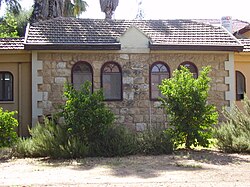Ben Shemen (Hebrew: בֶּן שֶׁמֶן, lit. very fruitful) is a moshav in central Israel. Located around four kilometres east of Lod, it falls under the jurisdiction of Hevel Modi'in Regional Council. In 2022 it had a population of 881.[1]
Ben Shemen
בֶּן שֶׁמֶן | |
|---|---|
 | |
| Coordinates: 31°57′14″N 34°55′30″E / 31.95389°N 34.92500°E | |
| Country | Israel |
| District | Central |
| Council | Hevel Modi'in |
| Affiliation | Moshavim Movement |
| Founded | 1905 (original) 1952 (re-establishment) |
| Population (2022)[1] | 881 |

Etymology edit
The village's name is taken from Isaiah 5:1:[2]
Let me sing of my well-beloved, a song of my beloved touching his vineyard. My well-beloved had a vineyard in a very fruitful hill.[3]
and also reflects the JNF's planting of olive trees in this area.[4]
History edit
The moshav was founded in 1905 on the land of the former Arab estate of Bayt ‘Arīf.[5] It was one of the first villages established on Jewish National Fund land.[4] The first Jewish National Fund forest is also located in Ben Shemen.[4] In 1910 Ben Shemen was the site of the Bezalel Artists' Colony (1910), a predecessor to the Ben Shemen youth village.[5] According to a census conducted in 1922 by the British Mandate authorities, Ben Shemen had a population of 90 Jews.[6] Which had increased in the 1931 census to 353 residents, in 30 houses.[7] In 1923 it was split in two, with a group of trial farms eventually becoming a separate moshav, Kerem Ben Shemen.
The Ben Shemen Youth Village was established adjacent to the moshav in 1927 and is today a large agricultural boarding school.[8][4] In 1945, the lands of Ben Shemen amounted to 2,176 dunams, of which 607 dunams were devoted to orchards, 947 dunams to field crops, one dunam for bananas, and 594 dunams were left uncultivated. According to Marom, "Citrus growing remained undeveloped in Ben Shemen, with the youth village specializing in orchards and field crops".[9]
During World War II, Ben Shemen was the site of a British search for weapons. Similar searches were a common British response to Jewish opposition to the White Paper of 1939.[10] In 1947 Ben Shemen had a population of 75.[4] The village experienced extensive damage during the early days of the 1948 Arab–Israeli war and had to be reconstructed.[4] Immigrants from Romania joined the moshav in 1952. Some houses were built by Bezalel Academy of Art and Design founder Boris Schatz.
-
Ben Shemen 1942 1:20,000
-
Ben Shemen 1945 1:250,000
-
Depopulated villages in the Ramle Subdistrict
-
Ben Shemen 1927
-
Ben Shemen 1928
-
Ben Shemen 1948. Photograph from Palmach archive
-
Ben Shemen. 1948. Used as a base by the Yiftach Brigade
-
Ben Shemen 1948. Dining room
-
Ben Shemen. Harvest
-
Ben Shemen. Processing wool
-
Ben Shemen being evacuated in early 1948
Archaeology edit
During road-work near Ben Shemen in 1975, a burial cave containing three ossuaries was found. An Aramaic funerary inscription on one of them mentions "Levi son of Menashe" and is dated to the late Second Temple period, probably during the first century BCE or CE.[11]
Additionally, a boulder that collapsed from the cave wall had a Greek funerary inscription written in red, which according to its style, was probably inscribed during the 2nd or 3rd centuries CE. Di Segni suggested that the appearance of the Hebrew name "Yo'ezer" on the inscription indicates that the area had not been completely cleared of Jews after the Jewish–Roman wars. Jews who did not participate in the revolt may have survived in the area, converting to Christianity and preserving the family name for generations to come. Others have argued that, despite its rarity, a Christian usage of an Old Testament name doesn't require additional explanation.[11][12]
Notable residents edit
See also edit
References edit
- ^ a b "Regional Statistics". Israel Central Bureau of Statistics. Retrieved 21 March 2024.
- ^ Vilnay, Zev, Rachel and Oren: The Vilnay Guide to Israel. A new Millenium edition, Vol 1: Jerusalem, Beersheba and Southern Israel, Atlit 1999, p. 212, ISBN 965-90269-0-0
- ^ Isaiah Chapter 5 Mechon Mamre
- ^ a b c d e f Jewish National Fund (1949). Jewish Villages in Israel. Jerusalem: Hamadpis Liphshitz Press. p. 16.
- ^ a b Marom, Roy (2022-11-01). "Jindās: A History of Lydda's Rural Hinterland in the 15th to the 20th Centuries CE". Lod, Lydda, Diospolis. 1: 26–27.
- ^ "Palestine Census ( 1922)".
- ^ Mills, 1932, p. 19
- ^ Roth, Chaya H. (September 16, 2008). The fate of Holocaust memories: transmission and family dialogues. New York, NY: Palgrave Macmillan. p. 83. ISBN 9780230606074.
- ^ Marom, Roy (2022-11-01). "Jindās: A History of Lydda's Rural Hinterland in the 15th to the 20th Centuries CE". Lod, Lydda, Diospolis. 1: 25–26.
- ^ Anita, Shapira (1992). Land and Power, The Zionist Resort to Force. Oxford: Oxford University Press. p. 288.
- ^ a b Corpus inscriptionum Iudaeae/Palaestinae: a multi-lingual corpus of the inscriptions from Alexander to Muhammad. Vol. IV: Iudaea / Idumaea. Eran Lupu, Marfa Heimbach, Naomi Schneider, Hannah Cotton. Berlin: de Gruyter. 2018. pp. 61–65. ISBN 978-3-11-022219-7. OCLC 663773367.
{{cite book}}: CS1 maint: others (link) - ^ Di Segni, Leah; סגני, לאה די (2013). "כתובת ביוונית מהתקופה הרומית המאוחרת ממערת קבורה מס' 4 בבן שמן / A Greek Inscription from the Late Roman Period in Burial Cave 4 at Ben Shemen". 'Atiqot / עתיקות. 73: 67–70. ISSN 0792-8424. JSTOR 23466596.
External links edit
- Ben Shemen, Cross-Israel Highway: Reproduction of an oil press Israel Antiquities Authority
